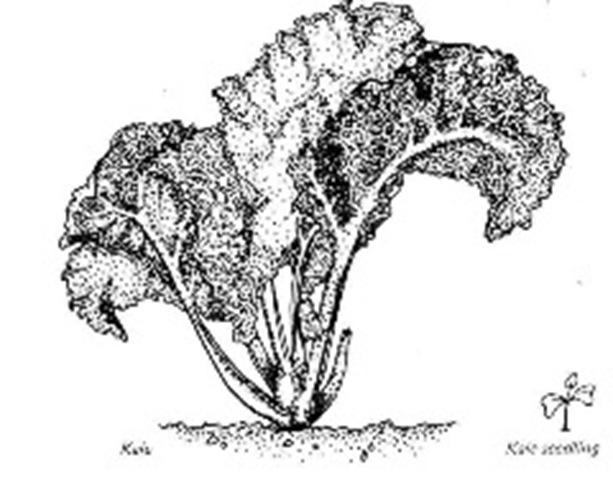Common names: kale, borecole, collards, green cabbage, German greens
Botanical name: Brassica oleracea acephala
Origin: horticultural hybrid
Varieties
Dwarf Blue Curled (55 days); Dwarf Blue Scotch (55 days); Vate; (55 days); Dwarf Green Curled (60 days).
Description
Kale is a hardy biennial plant grown as an annual. It’s a member of the cabbage family and looks
like cabbage with a permanent wave. Scotch kale has gray-green leaves that are extremely crumpled and curly; Siberian or blue kale usually is less curly and is a bluer shade of green. There are also decorative forms with lavender and silver variegated leaves.
Where and when to grow
Kale is a cool-weather crop that grows best in the fall and will last through the winter as far north as Maryland and central Indiana. Frost even improves the flavor, and kale is better adapted for fall planting throughout a wide area of the United States than any other vegetable. Kale doesn’t tolerate heat as well as the collard — which it resembles in being one of the oldest members of the cabbage or cole family. All cole crops are frost-hardy and can tolerate low 20°F temperatures. Kale does best in a cool growing season with day temperatures under 80°F. Time plantings so that you can harvest kale during cool weather. If your area has cold winters, plant for summer to early fall harvest. In mild climates, plant for late spring or early fall harvest. In the South, plant for harvest in late fall or winter. Plant kale from transplants early in the spring and again in the midsummer if your summers aren’t too hot. Direct-seed in the fall.
Flowering varieties of kale can be planted in containers or as accent points in a flower bed. The leaves are attractive, and their color is at its best in cool fall weather.
How to plant
Kale likes fertile, well-drained soil with pH within the 6.5 to 7.5 range; this discourages disease and lets the plant make the most of the nutrients in the soil. Kale is

usually grown from transplants except where there is a long cool period, in which case seed can be sown directly in the garden in fall for winter harvest.
When you’re preparing the soil for planting, work in a complete, well-balanced fertilizer at the rate of one pound per 100 square feet or 10 pounds per 1,000 square feet. If you have sandy soil or your area is subject to heavy rains, you’ll probably need to supplement the nitrogen content of the soil. Use about a pound of nitrogen fertilizer for a 10-foot row.
Plant transplants that are four to six weeks old, with four or five true leaves. If the transplants are leggy or have crooked stems, plant them deeply (up to the first leaves) so they won’t grow to be top-heavy. Plant the seedlings eight to 12 inches apart, in rows 18 to 24 inches apart. If you’re planting seeds, set them half an inch deep and space them three inches apart. Thin them when they’re big enough to lift by the true leaves, and either transplant the thinned seedlings or eat them right away.
Fertilizing and watering
Fertilize before planting and again at midseason, at the same rate as the rest of the garden. Detailed information on fertilizing is given in “Spadework: The Essential Soil” in Part 1.
Abundant soil moisture and cool moist air are needed for the best growth. Regular watering keeps kale growing strongly and prevents it from getting tough.
Pests
The cabbage family’s traditional enemies are cutworms and
caterpillars. Cutworms, cabbage loopers, and imported cabbage worms can all be controlled by spraying with bacillus thuringiensis, an organic product also known as Dipel or Thungicide. Kale does not suffer too much from pests, so it’s a good choice for the organic gardener. Detailed information on pest control is given in “Keeping Your Garden Healthy” in Parti.
Diseases
Kale has no serious disease problems.
When and how to harvest
Time from planting to harvest is 55 days from transplants, 70 to 80 days from seed. A 10-foot row will produce about 10 plants. Leave kale in the garden until needed. As the plants mature, take outside leaves, leaving the inner ones to grow, or cut off the entire plant. But harvest kale before it gets old and tough.
Storing and preserving
If possible, leave kale in the garden until you want to eat it. It will store in the refrigerator in a plastic bag for up to one week, or in a cold, moist place for up to three weeks. You can also freeze, can, or dry it; use the recipes for greens. Detailed information on storing and preserving is given in Part 3.
Serving suggestions
Young kale makes a distinctive salad green; dress it simply with oil and vinegar. You can also cook it in a little water and serve it with butter, lemon juice, and chopped bacon. Instead of boiling, try preparing it like spinach steamed with butter and only the water that clings to the leaves after washing. The Italians steam kale until tender, then add olive oil, a little garlic, and breadcrumbs, and sprinkle it with Parmesan cheese in the last minute or two of cooking. You can also prepare kale Chinese-style, stir-fried with a few slices of fresh gingerroot.
